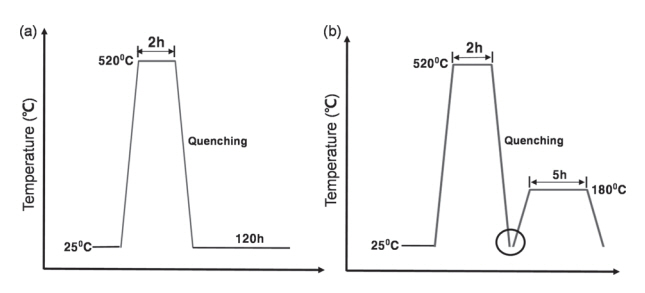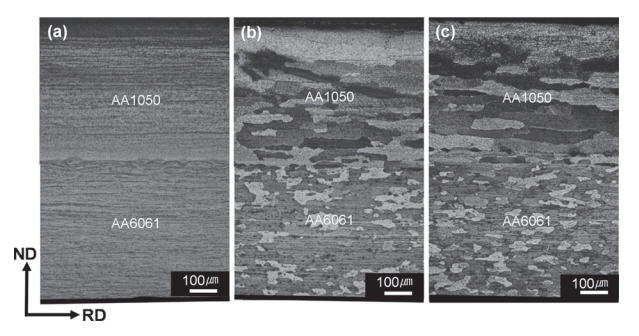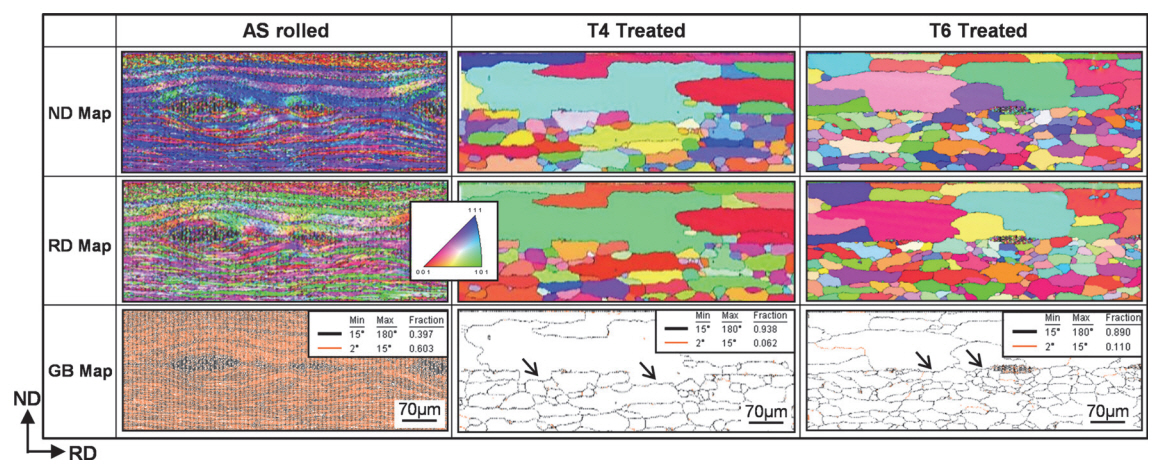1. INTRODUCTION
A great number of studies have been conducted on ways to reduce the weight of automobiles because of the current interest in energy conservation and eco-friendliness [1-8]. An aluminum alloy sheet is a promising material for automotive body panels because of their benefits, including medium strength, good formability and lightweight [9-11]. It is also expected that substituting such Al alloys for steels will result in great improvements in energy economy, recyclability and life-cycle cost. Accordingly, further research to develop unique Al alloys to satisfy both strength and ductility is needed for future applications in the automotive industry.
The cold roll-bonding (CRB) process is one way to design various layered (clad) materials with promising mechanical properties [12-16]. Compared with other various processes, CRB is considered to be so effective because it can be easily automated and is simple to set up as a continuous process system. As another advantage, CRB can be used to fabricate various kinds of layered materials with various combinations of metallic sheets. Many studies have been carried out on the fabrication and evaluation of various layered materials processed by the CRB.
However, there are only a few studies on multi-layer Al alloys prepared by the CRB process, even though they have great potential given their mechanical properties. The authors have studied the fabrication of multi-layer complex aluminum alloy sheets using CRB [15,16]. The previous studies using CRB with various Al alloys, confirmed the potential fabrication of Al based layered materials with excellent mechanical properties [15,16]. The number of stacks in the CRB is expected to affect the mechanical properties of the layered materials. However, there are no studies on the effects of the stacking number on the microstructure and mechanical properties of the layered materials. Therefore, the present study aimed to evaluate the effects of the stacking layer number on the microstructures and mechanical properties of Al layered materials fabricated by the CRB process.
2. EXPERIMENTAL
The materials used in this study are commercial AA1050 and AA6061 Al sheets with chemical compositions shown in Table 1. The as-received Al materials had thicknesses of 2 mm, width of 40 mm, and length of 300 mm, and were annealed for 0.5h at 400℃ to remove the residual stress of the starting materials.
As shown in Fig 1, the 2 and 4-layer sheets of AA1050 and AA6061 were alternately stacked after surface treatments such as degreasing and wire brushing. The rolling was then performed at a speed of 5.0 m/s by a two-high mill with a diameter of 210 mm without lubricant at ambient temperature for the layered Al sheets. The resulting 4 mm 2-layer Al sheets and 8 mm 4-layer Al sheets were reduced to thickness of 0.5 mm and 1 mm by rolling, respectively. The total reduction was the same, 75%, for both the 2-layer and 4-layer stacked CRB.
The as roll-bonded Al sheets were then processed by natural aging (T4) and artificial aging (T6) treatments, as shown in Fig 2.
The microstructures of the multi-layer Al sheets were revealed by optical microscopy and scanning electron microscopy (SEM) observation. SEM/EBSD measurement was also carried out using a program TSL OIM Data Collection ver.3.5 in Phillips XL30s SEM with FE-gun operated at 20kV. The EBSD analysis was performed using a program TSL OIM Analysis ver. 3.0. The mechanical properties were examined at ambient temperature by an Instron-type tensile testing machine. The tensile test pieces were machined so that the tensile direction was parallel to the rolling direction. The gauge length and width were 32mm and 6mm, respectively, and the initial strain rate was 10-3s-1. The variation in Vickers hardness in the thickness direction of the Al sheets was also measured with a load of 0.98N.
3. RESULTS AND DISCUSSION
3.1 Microstructure
Fig 3 shows the optical microstructures observed on the plane perpendicular to the transverse direction (TD plane) of the as-rolled and the age-treated specimens for 2-layer CRB. The as-rolled specimen [Fig 3a] showed a typical deformation structure in which the grains are elongated in the rolling direction in both the AA1050 and AA6061 regions. However, the T4 and T6 age-treated specimens had a typical recrystallization structure over all regions even though the grain size in AA6061 region was smaller than that in AA1050 region.
Fig 4 provides the normal direction (ND), transverse direction (TD) and grain boundaries (GB) maps measured near the bonded interface of the as-rolled and the agingtreated specimens. The as-rolled specimen showed a typical rolling texture, in which the {110}<111> component developed primarily in both AA1050 and AA6061 regions. However, for the T4 and T6-treated specimens, the texture was not as strongly developed in both regions. The grain size in AA1050 region was distinctly larger than that in AA6061 region, as shown in the results of the optical microstructure. The average grain diameters were 112μm and 48μm in AA1050 and AA6061 regions for the T4 specimen, respectively. For the T6 specimen, it was also 85μm and 32μm in the AA1050 and AA6061 regions, respectively.
These results indicate that the grain size is smaller in the T6 specimen than in the T4 specimen. In addition, the GB map indicates that the fraction of low-angle grain boundaries (LAGB) below 15 degrees was higher than that of the highangle grain boundaries (HAGB) above 15 degrees for the asrolled specimen, but for the T4 and T6-treated ones, the opposite results were found. It is thought that this is probably caused by the annihilation of subgrains during the solution treatment. In addition, it is noteworthy that the grains grew beyond the interface between the AA1050 and AA5052 to each other in both the T4 and T6 specimens, as indicated by the arrows. This suggests that the bonding between the dissimilar Al sheets was sufficiently established after the aging treatments.
The ND, TD and GB maps measured at various regions of the as-rolled and the T6-treated specimens for 4-layer CRB are shown in Fig 5. The as-rolled and the T6-treated specimens showed a deformation and a recrystallization structure respectively, similar to those in the 2-layer CRB. The grain size was also larger in the AA1050 region than in the AA6061 region for the T6-treated specimen, as the 2-layer CRB. The bonding between both Al sheets was so sound that it was difficult to determine the interface between AA1050 and AA6061, as shown in the figure. In addition, the average grain diameters of the T6-treated specimens were 78μm and 30μm in the AA1050 and AA6061 regions, respectively. This means that the grain size of the specimen from the 4-layer CRB was slightly smaller than that of the 2-layer CRB in all regions.
3.2 Mechanical Properties
Fig 6 shows the hardness distribution in the thickness direction of the starting materials and the 2 and 4-layer CRB specimens. Both starting materials showed relatively homogeneous hardness distribution due to the as-annealed state, even though the hardness of the AA6061 was higher than that of AA1050. The as roll-bonded and the age-treated specimens had layered structures in which the AA1050 and AA6061 sheets are stacked alternately to each other, showing higher hardness in the AA6061 regions than in the AA1050 regions, regardless of the stacking number. The roll-bonded specimens had significantly higher hardness than those of the starting materials, due to the work hardening by the cold rolling.
It was also found that the increase in hardness produced by the work hardening was larger in the AA1050 regions than in the AA6061 regions in both the 2-layer and 4-layer CRB. After T4 treatment, the hardness decreased largely in the AA1050 regions, compared with the AA6061 regions. The decrease in hardness is due to the recrystallization that occurred during solution treatment. The decrease in hardness in the AA6061 regions was not as large as in the AA1050 regions due to the age hardening produced by the T4 treatment. As a consequence, the difference in hardness between the AA1050 and AA6061 regions largely decreased after the T4 treatment.
However, the T6 treated material showed a different hardness distribution than the T4 treated ones, as shown in the figure. The hardness increased largely in the AA6061 region, even though it decreased in the AA1050 region, compared with those of the as-rolled specimens. This is due to a significant increase in hardness by the T6 treatment. It is very interesting that the hardness distribution is reversed by the aging treatment. It is also notable that layered Al alloys with various hardness distribution in the thickness direction can be fabricated by the CRB and aging treatments.
Fig 7 shows nominal stress-nominal strain(s-s) curves (Fig 7a) and the mechanical properties (Fig 7b) of the asrolled and the age-treated materials for the 2-layer stack CRB. The starting materials in the AA1050 and AA6061 sheets showed relatively low tensile strength and high elongation due to fully annealed state. The average tensile strength and elongation were calculated to be 120 MPa and 36 %, respectively, according to the mixture rule. The strength of the roll-bonded material was greatly increased to 280 MPa and the elongation was significantly reduced by 5%. After the T4 and T6 age treatments, the strength was decreased and the elongation increased, compared with the as-rolled material, as shown in Fig 7b. Here, the strength of the T6-treated material (183MPa) was higher than that of the T4-treated one (170MPa). In addition, the amount of work hardening, the difference between the tensile strength and yield strength, was the highest in the T4-treated material, as shown in Fig 7b.
Fig 8 shows the nominal stress-nominal strain(s-s) curves (Fig 8a) and the mechanical properties (Fig 8b) of the 4-layer stack CRB. The strength of the roll-bonded specimen was 313MPa, which is the highest among the experimental conditions. This value is 2.6 times that of the starting material. Similar to the 2-layer CRB, the strength decreased and the elongation increased after the T4 and T6 age treatments. In addition, the strength of the T6-treated material (194MPa) was slightly higher than that of the T4-treated one (187MPa). The amount of work hardening was also the highest in the T4-treated material, similar to that of 2-layer CRB.
However, the detailed comparison between Fig 7 and Fig 8 revealed that there was a significant difference in mechanical properties between the 2-layer and 4-layer stack CRB. Fig 9 is the comparison of mechanical properties of the 2 and 4-layer stack CRBs. As shown in the figure, both the strength and the elongation in the 4-layer CRB were superior to those of the 2-layer CRB. The figure indicates that the increment in strength is due to an increase in yield strength, caused probably by the increase in stacking number, followed by grain refinement and oxides in the bonded interfaces.
Fig 8 also shows that the increase in elongation is due to an increase in local (not uniform) elongation, as indicated by the arrows. The local elongation is primarily related to the strain rate sensitivity, called m-value. The flow stress is often adequately represented by the following equation [17].
where ε ˙ T
In this study, it is considered that the 4-layer alternating stacking of the AA1050 and AA6061 sheets contributed to the increase in the m-value, resulting in the increase in local elongation. It is interesting to study the reasons why both strength and elongation were better in the 4-layer than 2-layer stacking CRB. In this CRB, the difference in stacking number is considered to lead to a difference in the amount of oxides introduced into the Al sheet by the CRB, the heterogeneity in microstructure due to the stacking of dissimilar Al sheets following the difference in grain size, and also the difference in the roll gap shape ratio (L/hm) due to different rolling conditions [18].
Here, the grain refinement and the oxides in the bonded interfaces could contribute to the higher yield strength of the 4-layer stack CRB, compared to the 2-layer stack CRB. In addition, the heterogeneity in microstructure could affect the difference in mechanical properties between both CRB processes. It is well known that materials with a bimodal structure consisting of ultrafine and coarse grains exhibit not only high strength but also large elongation. The specimens fabricated by the CRB in this study formed a kind of bimodal structure in both the 2- and 4-layer CRB processes.
The difference in grain size of the AA1050 and AA6061 was not large enough to bring about a difference in the mechanical properties of the 2-layer and 4-layer stack CRB processes. However, it is considered that the difference in the degree of the heterogeneity in microstructure in the thickness direction, caused by the difference in the stacking number, probably influenced the observed difference in mechanical properties.
Now, let us discuss the difference in the roll gap shape ratio, expressed as the following equation [18].
Here, L is the contact projection length between the roll and workpiece and hm is the average thickness of the material before (h0) and after rolling (h1), and R is the radius of the rolls. If we calculate the (L/hm) values by substituting the corresponding values for the 2-layer and 4-layer stack CRBs, we obtain 11.5 and 8.1, respectively. In general, the larger the (L/hm) value is, the smaller the grain size developed by subsequent heating is, because the shear (thereby, equivalent) strain introduced by the rolling is increased [18]. Therefore, the 2-layer stack CRB is more advantageous for grain refinement from the viewpoint of the roll gap shape ratio. However, the average grain size after aging treatments was rather smaller in the 4-layer compared with the 2-layer CRB. This also means that the roll gap shape ratio hardly affected the difference in mechanical properties between 2-layer and 4-layer stack CRB.
Consequently, the difference in the number of stacks and, thereby the enhanced heterogeneity in microstructure and the introduction of many oxides resulted in the difference in the mechanical properties of the 2- and 4-layer stack CRBs. In any case, it can be concluded that the 4-layer stack CRB has superior mechanical properties compared to the 2-layer stack CRB in this study.
4. CONCLUSIONS
The effects of stacking number on microstructure and mechanical properties were studied for the CRB process using dissimilar Al sheets. The as roll-bonded Al sheets contained the typical deformation structures, but after age treatment they showed a typical recrystallization structure consisting of coarse grains, regardless of the number of stacking layers. The grain size of the specimens from the 4-layer CRB was somewhat smaller than those of the 2-layer CRB in all regions. The as-rolled and the age-treated materials have layered inhomogeneous(bimodal) structures in which the AA1050 and AA6061 sheets are stacked alternately to each other, with higher hardness in the AA6061 regions than in the AA1050 regions, regardless of the stacking number. The strength of the roll-bonded materials was also significantly increased and the elongation was greatly decreased, compared to the starting materials. After T4 and T6 age treatments, the strength decreased and the elongation increased due to an occurrence of recrystallization. Both the strength (yield strength) and the elongation (local elongation) were higher in the 4-layer CRB than in the 2-layer CRB process due to the higher stacking numbers, and accordingly, due to the increase in the heterogeneity of microstructure in the thickness direction and the introduction of many oxides. Conclusively, the 4-layer stack CRB exhibited superior mechanical properties, compared to the 2-layer stack CRB.




















